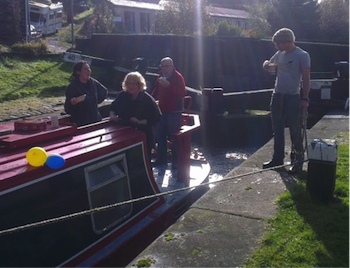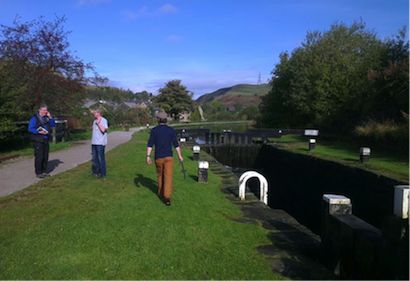
What is in a self-organizing team ??
I get a lot of push back on this – especially when doing Mingle implementations. People inevitably start down the “Access control” route.
“So I should make it so only QA’s can move a card to done! Right?”
Wrong! I think so anyway – It is true that the QA should be the only person actually exercising this change, but don’t restrict it because you then create critical dependencies on someone in that group!

Capt Scrubhead, t’Unicorn, Rock Pig and 7 fingers in a lock
“But,” they say “If I don’t then ANYONE can do it!” – Correct – But how dumb would you have to be??
On most cars anyone inside the car can pull the handbrake! They don’t however because its stupid!
The idea that one of your team members will go into a Mingle instance and maliciously alter your cards is the same as a passenger pulling the handbrake – If that is happening you have MUCH bigger problems than access control :)
So why start a post about self-organizing teams with a rant about access control? Easy – if you force people into roles they will only do that role!
Project
As an example I went on a canal boating holiday across the Pennines (A mountain range in the UK) last week. Canal boating quite simply involves driving a boat on a narrow winding canal (this one goes over a mountain range) at perhaps 4-5 miles/hour and involves a LOT of locks - a device for raising and lowering boats between stretches of water of different levels. These things have loads of moving parts and a load of tasks have to be executed to operate each lock. There is quite a lot to do.
Now we had a particular lock we needed to get to by a time and that was all the “team” knew. We had 3 windlass handles, some ropes, a British waterways key and... not enough time.
Considering this was all for a mate’s birthday no one really wanted to turn around and give everyone jobs – it was a pretty free flowing affair.
Plan
We started by establishing a common goal. Get the boat to the controlled lock at the summit by 1 pm for our appointment, passing through 10 locks and a few miles of canal en route. We estimated 10 minutes per lock. We all believed it was possible.
Process
A couple of the guys who grabbed some lock handles and hopped off the boat were our “lock/ground crew”. At the first lock we were delayed to drain it. The ground crew discussed this while the lock cycled and dispatched one with a lock handle off up the canal to see if the next lock needed to be drained (Retrospective?)
When we got to the next lock there was a brief delay as the doors opened and the lock crew again discussed how this one had gone. Once again the forward lock guy headed off up the canal to the next lock. I had inherited holding the rope to stop the boat from getting smashed. One of our team had taken over driving duties and the most hung-over of us put the kettle on and kept the various team members fed on tea / beer / etc.
When we got to the next one the lock had been prepped so well by the guy before all we needed to do was close the doors and start the water coming in. The lock crew had another brief retrospective and dispatched another of their crew up the lock to pass the revisions on to the forward lock hand with the British waterways key. From then on we were like a perfectly oiled machine, cranking through the locks just about as fast as was conceivably possible. “Rock Pig” and “Capt Scrubhead” were plying everyone with tea, biscuits, beer, etc. The team wanted for nothing while performing their primary duties and we were unstoppable
Results
We didn’t make the appointment – Our initial estimate of 10 minutes / lock was out by about 5 minutes, which meant we should have been 50 minutes late. However we were only 20 minutes late. The team had very rapidly worked out the most efficient way to achieve the goal in question of their own volition. They self organized into the leanest lock crew you have ever seen.
At one of the last locks we caught another boat – I was driving by this point and the guy on the other boat asked me “So who is the skipper?” – I thought for a moment and realized we didn’t have one. No one was “in control” – everyone was executing towards a common goal to the very best of their abilities and communicating with every other team member – we didn’t need one! So I said what anyone would have…“Me” I replied :)
Retrospective
The primary components that drove this brilliant self-organization were:
- The team were free to adjust anything they could control and discussed how to be more efficient at each lock
- They all took it upon them selves as a personal challenge to achieve the impossible – It was the team vs. the canal and they wanted to win!
- Any and all needs they had regarding food / water – etc. were delivered quickly and efficiently by the tea and biscuits crew meaning they had little or no distractions from their primary task.
The end result of this particular adventure is that no one could have organized it any better – We all knew where we were and where we wanted to be and set about as a team finding the most efficient way of achieving this goal. I believe it was General George Patton who said “Tell a man what you want him to do and he will oblige, Tell him the goal you wish to achieve and he will astound you with his ingenuity.” All too often we tell teams what we want them to do rather than the goal we want to get to. I think the latter is the best way to build a high performing agile team.

The Team
Dave “t’Unicorn” - Forward lock and Crankshaft Operator 0
Chris “SA” Crankshaft Operator 1
Luke “Wangler” Crankshaft Operator 2
Richie “Capt. Massive” Persuader of stubborn Objects / Crankshaft Operator as required
Mick “Capt. Cutthroat” Caressing of Diesel – Running into things.
Yours truly “7 fingers” ropes and general dogs body
Lisa “Capt. Scrubhead” Provisions / Biscuits
Abigail “Rock Pig / Galley Slave ” Tea and general hung over duties.
Pete “Peg No Leg” anything a man with a genuinely broken leg was up to (Chucking ropes being one)
Disclaimer: The statements and opinions expressed in this article are those of the author(s) and do not necessarily reflect the positions of Thoughtworks.














